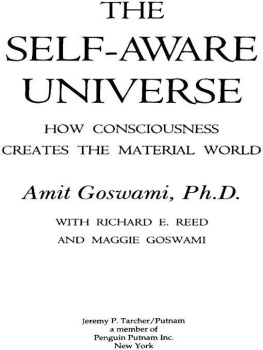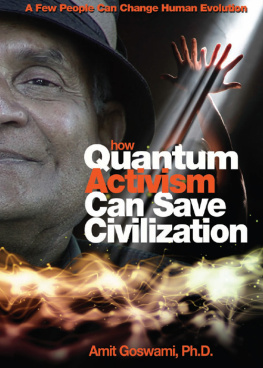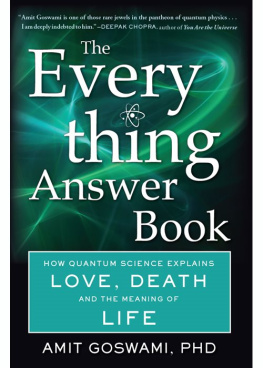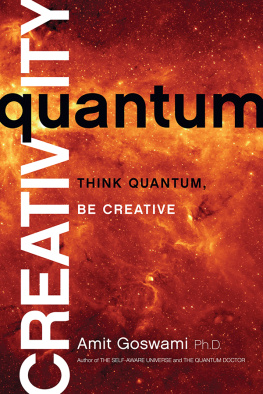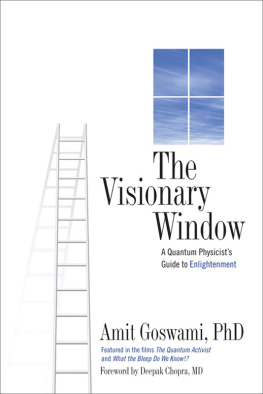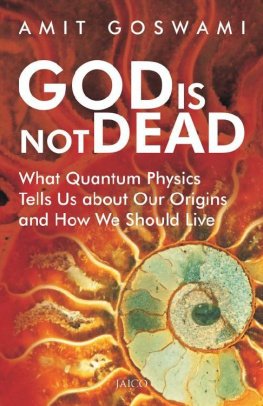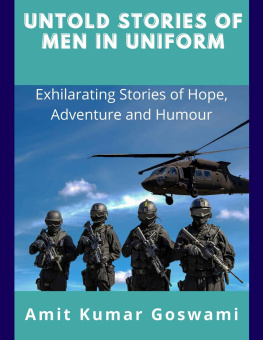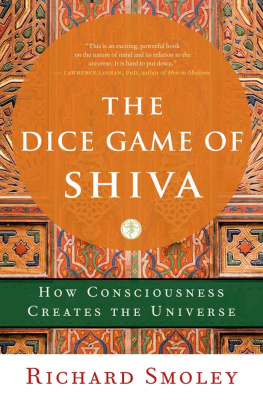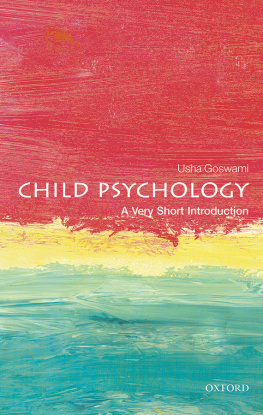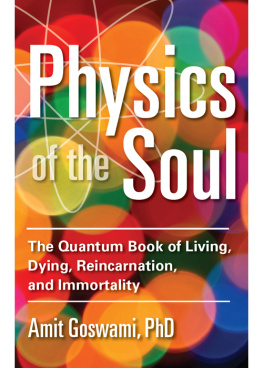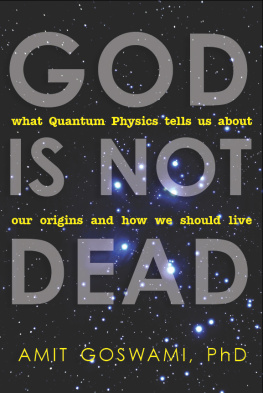Table of Contents
ALSO BY AMIT GOSWAMI
The Concepts of Physics
Quantum Mechanics
With Maggie Goswami
The Cosmic Dancers
Most Tarcher/Putnam books are available at special quantity
discounts for bulk purchases for sales promotions, premiums,
fund-raising, and educational needs. Special books or book excerpts
also can be created to fit specific needs.
For details, write Putnam
Special Markets, 375 Hudson Street
New York, NY 10014
To my brother the philosopher
Nripendra Chandra Goswami
Jeremy P. Tarcher/Putnam
a member of
Penguin Putnam Inc.
375 Hudson Street
New York, NY 10014 www.penguinputnam.com
First trade paper edition 1995
Copyright 1993 by Amit Goswami, Richard E. Reed, and Maggie Goswami
All rights reserved. This book, or parts thereof,
may not be reproduced in any form without permission.
Published simultaneously in Canada
Library of Congress Cataloging-in-Publication Data
Goswami, Amit.
The self-aware universe : how consciousness creates the material
world / Amit Goswami with Richard E. Reed and Maggie Goswami.
p. cm.
Includes bibliographical references and index.
eISBN : 978-1-440-67427-3
1. Quantum theory. 2. PhysicsPhilosophy. 3. Science-Philosophy
4. Religion and science. I. Reed, Richard E.
II. Goswami, Maggie. III. Title.
QC174-13-G-32178 CIP
530.12dc20
http://us.penguingroup.com
ILLUSTRATIONS
1. The quantum jump 27
2. Unstable orbits 28
3. Bohr orbit and the quantum jump 29
4. Graphic representation of a wave 32
5. Harmonics of a stationary wave 33
6. Wave model of the atom 33
7. Diffraction rings of electrons 34
8. Wave packet 36
9. Probability distribution 37
10. Electron track in vapor cloud 40
11. Measurement of electron orbit 41
12. My Wife and My Mother-in-Law 44
13. The yin-yang symbol 49
14. Double-slit experiment 67
15. Wave interference 68
16. Interference pattern on a screen 69
17. Observing the particle nature of electrons in a slit experiment 70
18. Electron wavicle nature in a slit experiment 71
19. The W-Eagle sequence 72
20. The delayed-choice experiment 74
21. The paradox of Schrdingers cat 79
22. The Bohr-Heisenberg microscope 89
23. The mechanics of seeing 90
24. Spring-mounted double-slit experiment 92
25. Quantum interference in SQUID 93
26. The von Neumann chain 95
27. The prisoners dilemma 99
28. Experiments with polarized photons 101
29. The Einstein-Podolsky-Rosen correlation 114
30. Observations of polarization-correlated photons 118
31. How a Bell inequality arises 124
32. Print Gallery, by M. C. Escher 180
33. Drawing Hands, by M. C. Escher 182
34. The Uroboros 189
PREFACE
When I was a graduate student studying quantum mechanics, a group of us would spend hours discussing such esoterica as, Can an electron really be at two places at the same time? I could accept that, yes, the electron can be at two places at the same time; the message of quantum mathematics, although full of subtlety, is unambiguous on this point. Does an ordinary object, howevera chair or a desk, things that we call realbehave like an electron? Does it become a wave and start spreading in the waves inexorable way whenever no one is looking?
Objects found in our everyday experience do not seem to behave in the strange ways common to quantum mechanics. Thus, subconsciously, it is easy for us to be lulled into thinking that macroscopic matter is different from microscopic particlesthat its conventional behavior is governed by Newtonian laws, which are referred to as classical physics. Indeed, many physicists stop puzzling over the paradoxes of quantum physics and succumb to this solution. They divide the world into quantum and classical objectsand so did I, although I did not realize what I was doing.
To forge a successful career in physics, you cannot worry too much about such recalcitrant questions as the quantum puzzles. The pragmatic way of doing quantum physics, I was told, is to learn to calculate. I therefore compromised, and the tantalizing questions of my youth gradually shifted to a back burner.
They did not, however, disappear. Circumstances shifted for me, andafter my umpteenth bout of the stress heartburn that characterized my competitive-physics careerI began to remember the exuberance I once felt about physics. I realized that there must be a joyful way of approaching the subject, but I needed to restore my spirit of inquiry into the meaning of the universe and to abandon the mental compromises I had made for career motives. A book by the philosopher Thomas Kuhn that distinguishes paradigm research from scientific revolutions that shift paradigms was very helpful. I had done my share of paradigm research; it was time to move on to the frontier of physics and to think about a paradigm shift.
Just about the time of my personal crossroads, Fritjof Capras book The Tao of Physics came out. Although my initial reaction to the book was jealousy and rejection, it did touch me deeply. After a while I could see that the book broaches a problem that it does not investigate thoroughly. Capra delves into the parallels between a mystical view of the world and that of quantum physics but does not investigate the reason for these parallels: Are they more than coincidence? At last, I had found the focus of my inquiry into the nature of reality.
Capras entree to questions about reality was through elementary particle physics, but I intuited that the key issues are most directly confronted in the problem of how to interpret quantum physics. This is what I set out to investigate. I did not anticipate initially that this would be such an interdisciplinary project.
I was teaching a course on the physics of science fiction (I have always had a soft spot for science fiction), and a student commented: You talk like my psychology professor, Carolin Keutzer! A collaboration with Keutzer ensued that, although not leading to any major insight, did introduce me to a lot of relevant psychological literature. I eventually became familiar with the work of Mike Posner and his cognitive psychology group at the University of Oregon, which was to play a crucial role in my research.
Besides psychology, my subject of research demanded considerable knowledge of neurophysiologybrain science. I met my neurophysiology teacher through the mediation of John Lilly, the famous dolphinologist. Lilly had kindly invited me to participate in a week-long Esalen seminar that he was giving; Frank Barr, M.D., was also a participant. If my passion was quantum mechanics, Franks was brain theory. I was able to learn from him just about everything I needed to begin the brain-mind aspect of this book.
One other crucial ingredient for my ideas to gel consisted of the theories of artificial intelligence. Here, too, I was very fortunate. One of the exponents of artificial intelligence theory, Doug Hofstadter, began his career as a physicist; he earned his degree at the University of Oregon graduate school, where I teach. Naturally, when his book came out, I had a special interest in it and learned some of my key ideas from Dougs research.
The meaningful coincidences go on and on. I was initiated to the research in parapsychology through many discussions with another of my colleagues, Ray Hyman, who is a very open-minded skeptic. Last but not least of the important coincidences was my meeting with three mystics in Lone Pine, California, during the summer of 1984: Franklin Merrell-Wolff, Richard Moss, and Joel Morwood.


